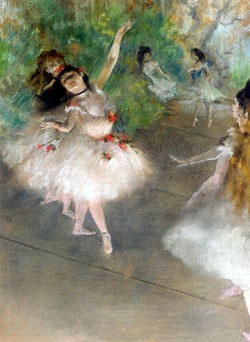A work that reminded me of something or someone in my life: the photograph by Thomas Struth titled 'Paradise.' It's a forest shot that reminds me greatly of the forests back in my home state, Washington. I couldn't help but to pass by intentionally while wandering through the museum.

A historic work: the Terracotta army excavated from China, which dates back to 210 BC. I particularly like this exhibit, simply because it's so old and shows a window into not just a different time, but a different culture, as well. Not to mention the expert craftsmanship and original details on each of the statues...
Liked but not for home: Gerhard Richter-11-Scheiben (11-Panels). It was an interesting piece, with eleven glass panels stacked against each other that gave a sort of blurred, distorted look. However, it would be a bit bigger than practical to keep in the home.


Shocked! Shocked, I tell you! And this is what it was: Two works, actually. The first thing was Jimmy Lee Sudduth's work 'Woman with Glasses.' It looked odd, yes, but what caused more surprise for me was the list of materials used. Mud, sugar or syrup, and paint on plywood. I can barely even imagine how one gets that to work. The other thing was Thorton Dial's 'Heckyll and Jeckyll: Pleasure for the People. The red and white colors really jumped out, and the work itself seemed to jump out literally. It was sort of a mess of stuff, but really cool. Both of these works were found in the folk art gallery, by the way.
Woman with Glasses by Jimmy Lee Sudduth
Something that felt sad: Robert Henri's 'Lady in Black Velvet.' Honestly, I don't see how this work couldn't feel at least somewhat sad. The woman is dressed in all black, like in mourning or preparing to go to a funeral. It makes you think and wonder.
Something I liked: Edward Ruscha's contemporary piece 'Home Power.' It looks like a photograph, but apparently it was done with acrylics. I liked this piece because when I first saw it from a distance, it looked like a spooky haunted house. Even though when you come closer and see the title of it, it looses some of the creepiness, but the first impression is awesome. The darkness that surrounds it gives off the eerie feeling of the unknown.
A work that taught me something I don't know: Soon to come...
What I noticed about the contemporary and folk arts: Okay, here goes. From what I happened to notice, there seemed to be a lot more materials used in folk art that one could get easily, like at a department store. Howard Finster's work 'MyFather's House are Many Mansions #4,392' uses a bunch of plastic toys, for instance. There was another work that seemed to use a lot of rhinstones and beads glued to make a person (will put up the name and artist to this if I can find it, by the way.) The folk art also seemed to indulge heavily in religious themes and surges of abstract and uncontained inspiration, such as Hallelujah Gate (another artist I can't remember) and Dial's 'Heckyll and Jeckyll: Pleasure for the People.' The contemporary art on the other hand seemed a lot more refined, some using oils that would be bought at an art shop that would be specifically more for that. Using mirrors like in Richter's '11-Scheiben' and other such materials also seemed to relate more to the industrial world rather than the world at home.
The most meaningful part of the trip: Soon to come~



















